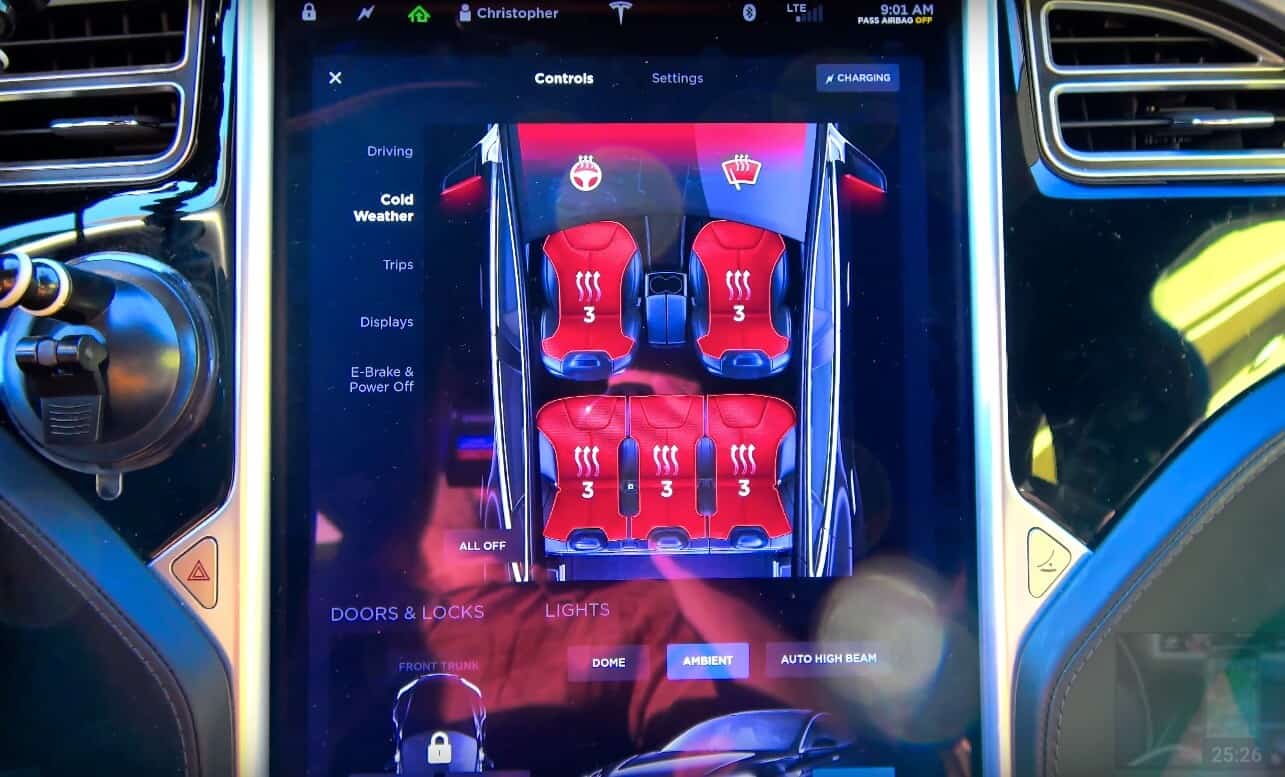Tesla Motors Inc owners living in cold climates will resort to the onboard climate control settings of their electric car and seat heaters to stay warm as winter months come closer and the temperatures begin to drop. This can seriously reduce the range the car as. However, Teslarati – with help from YouTuber and Model S owner, KmanAuto – managed to find out the most optimal way to stay warm in a Tesla.
Important to know the power consumption by each feature
Understanding the amount of power each component – onboard climate control settings and seat heaters – consumes, could “mean the difference between going that extra mile, especially when driving in snowy conditions could rob upwards of 25% in range, and being stuck at a Supercharger longer than need be,” notes Teslarati.

The YouTuber gave Teslarati an inside look on the amount of power the heating and air conditioning (HVAC) system and Tesla Motors Inc SubZero Weather Package consumes. The SubZero Weather Package is an optional add-on, which includes heated washer nozzles, heated wiper blades, seat heaters throughout the cabin and a heater steering wheel.
KmanAuto measured the quantity of current power and draw consumed by each feature within the Subzero package by using a third-party app named Remote S. Then, combining the HVAC heater with seat heaters at fan speeds, the Tesla Motors Inc Model S owner experiments with a series of tests, and notes power consumption with every combination.
What’s the optimal solution for Tesla Model S?
Kman turns on the heater to ‘HI’ (82F) at some point, which is mostly used by owners when they first get inside a frigid car, and measures 18+ miles of range lost per hour or 16.8A, 6.4kW of power consumed. Running the heater at HI for a complete hour seems like an unlikely scenario, considering the cabin temperature reached 108 degrees Fahrenheit (42C) quickly, within a short amount of time.
However, Kman notes that warming up a car quickly by using a heater could have significant effects on the range. Hence, it is advised to use seat heater as the basic source for warming yourself. At the same time, a slow warming of the in-cabin air by setting it to room temperature will assist as well, notes Teslarati.
Teslarati report has broken down the consumption of energy by feature. The overall energy consumption can be added together based on the number of features enabled. This can measure the approx. range loss at miles per hour (mph) assuming a consumption of 333Wh/mile.
Defroster (rear window & side mirror heaters): 285 Wh = .86 mph; Baseline (vehicle at rest but powered up): 247 Wh = .74 mph; Heated Wipers & Nozzles: 95Wh = .29 mph; Steering Wheel Heater: 95 Wh = .29 mph; HVAC at 74F (23C): 342 Wh = 1.03 mph; HVAC at ‘HI’ or 82F (28C): 6.4 kWh = ~18-20 mph; 1 Seat Heater: 57 Wh = .17 mph; 2 Seat Heaters: 133 Wh = .40 mph; 3 Seat Heaters: 171 Wh = .51 mph; 4 Seat Heaters: 209 Wh = .63 mph; 5 Seat Heaters: 247 Wh = .74 mph
Trusted & Regulated Stock & CFD Brokers
What we like
- 0% Fees on Stocks
- 5000+ Stocks, ETFs and other Markets
- Accepts Paypal Deposits
Min Deposit
$200
Charge per Trade
Zero Commission on real stocks
64 traders signed up today
Visit Now67% of retail investor accounts lose money when trading CFDs with this provider. You should consider whether you can afford to take the high risk of losing your money.
Available Assets
- Total Number of Stocks & Shares5000+
- US Stocks
- German Stocks
- UK Stocks
- European
- ETF Stocks
- IPO
- Funds
- Bonds
- Options
- Futures
- CFDs
- Crypto
Charge per Trade
- FTSE 100 Zero Commission
- NASDAQ Zero Commission
- DAX Zero Commission
- Facebook Zero Commission
- Alphabet Zero Commission
- Tesla Zero Commission
- Apple Zero Commission
- Microsoft Zero Commission
Deposit Method
- Wire Transfer
- Credit Cards
- Bank Account
- Paypall
- Skrill
- Neteller
What we like
- Sign up today and get $5 free
- Fractals Available
- Paypal Available
Min Deposit
$0
Charge per Trade
$1 to $9 PCM
Visit Now
Investing in financial markets carries risk, you have the potential to lose your total investment.
Available Assets
- Total Number of Shares999
- US Stocks
- German Stocks
- UK Stocks
- European Stocks
- EFTs
- IPOs
- Funds
- Bonds
- Options
- Futures
- CFDs
- Crypto
Charge per Trade
- FTSE 100 $1 - $9 per month
- NASDAQ $1 - $9 per month
- DAX $1 - $9 per month
- Facebook $1 - $9 per month
- Alphabet $1 - $9 per month
- Telsa $1 - $9 per month
- Apple $1 - $9 per month
- Microsoft $1 - $9 per month
Deposit Method
- Wire Transfer
- Credit Cards
- Bank Account


